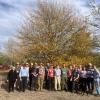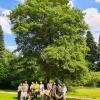Editor's Picks
Plant Focus
To create an account click here; if you have already registered, click here to become a member.
Individual articles can be purchased for U$S 10. If you would like to purchase an article, email a request to website@internationaloaksociety.org
Ronald Lance
Published May 2022 in International Oaks No. 33: 27–44
Introduction
The oak species generally known in the United States as “Durand oak” has been subject to multiple and discordant interpretations of its morphological, taxonomical, and nomenclatural significance. Its nomenclature is a particularly contentious issue and deserves a detailed explanation before further analyses of taxonomy are presented. This paper is a summary of the problems associated with recognition of Durand oak and an introduction to a research effort striving for remedial propositions. Throughout this article, the oaks of pertinence are most often referenced using their common colloquial names. The reason for frequent departure from specific epithets is for greater clarity: only one colloquial name is used for the oak of point, rather than one of the multiple epithets which are themselves a focus of nomenclatural dispute. The colloquial names used here are “Durand oak” (Quercus durandii, or Q. sinuata), “Bigelow oak” (Q. durandii var. breviloba, or Q. sinuata var. breviloba) and “bluff oak” (Q. austrina).
Three oak taxa are popularly considered representative of or allied to the Durand oak species complex (Photos 1-3). Taxonomic disagreement regarding the parameters of each taxon, whether deserving of specific, varietal, or synonymous status, has been ongoing since the beginning of the 19th century. Across the Southern United States, from Central Texas eastward across the Gulf and Atlantic Coastal Plains to South Carolina, these three oaks have remained more distinctive in appearance than in nomenclatural clarity.
References
Ashe, W.W. 1916. Notes on trees. Proc. Soc. Amer. Foresters 11: 88-90. Ashe, W.W. 1918. Notes on trees. Bull. Charleston Museum 14: 9-12.
Buckley, S.B. 1860. Description of several new species of plants. Proc. Acad. Nat. Sci. Philadelphia 12: 443-445. Buckley, S.B. 1861. Description of new plants from Texas. Proc. Acad. Nat. Sci. Philadelphia 13: 448-463. Buckley, S.B. 1862. Descriptions of new plants from Texas. Proc. Acad. Nat. Sci. Philadelphia 14: 5-10.
Buckley, S.B. 1873. In Familiar lessons in botany, with Flora of Texas, by M.J. Young. New York: A.S. Barnes. Buckley, S.B. 1881. Quercus durandii, Buckley. Proc. Acad. Nat. Sci. Philadelphia 33: 121-122.
Camus, A. 1938-1939. Les Chenes. Monographie du Genre Quercus. Tome II. Genre Quercus. Sous-genre Euquercus (Sections Lepidobalanus et Macrobalanus). Texte. Paris: Paul Lechevalier Editeur.
Dorr, L.J. and K.C. Nixon. 1985. Typification of the oak (Quercus) taxa described by S. B. Buckley (1809-1884). Taxon 34 (2): 211-228.
Engelmann, G. 1876. About the oaks of the United States. Proc. St. Louis Acad. Sci. 3: 372-400. Engelmann, G. 1877. The oaks of the United States. Proc. St. Louis Acad. Sci. 3: 539-543.
Hardin, J.W. 1976. Terminology and classification of Quercus trichomes. J. Elisha Mitch. Sci. Soc. 92: 151-161.
Little, E.L. 1979. Checklist of United States trees (native and naturalized). US Department of Agriculture, Handbook No.541.
Washington D.C.: Forest Service, US Dept. of Agriculture.
Mohr, C. 1901. Plant life of Alabama: an account of the distribution, modes of association, and adaptations of the flora of Alabama, together with a systematic catalogue of the plants growing in the state. Montgomery, Alabama: Brown Printing Co.
Muller, C.H. 1944. Fagaceae. In Plants of Coahuila, eastern Chihuahua, and adjoining Zacatecas and Durango, IV, by I.M. Johnston. J. Arnold Arb. 25(4): 437-450.
Muller, C.H. 1951. The oaks of Texas. Contr. Texas Res. Foundation. Bot. Stud. 1(3): 20-323.
Muller, C.H. 1970. Quercus. In Manual of the vascular plants of Texas, edited by D.S. Correll and M.C. Johnston. Renner Texas: Texas Research Foundation.
NYBG (New York Botanical Garden). 2006. Records of John Kunkel Small (RG4). Archives, the LuEster T. Merlin Library http://library.nybg.org/
Nixon, K.C. and C.H. Muller. 1997. Quercus L. sect Quercus. In Flora of North America. Oxford and New York: New York Univ. Press.
Palmer, E.J. 1945. Quercus durandii and its allies. Amer. Midl. Nat. 33: 514-519. Sargent, C.S. 1895. Gard. and Forest. 8: 93.
Sargent, C.S. 1895. The Silva of North America, Vol. 8. Boston and New York: Houghton Mifflin and Co. Sargent, C.S. 1905. Manual of the trees of North America (exclusive of Mexico). Boston: Houghton Mifflin. Sargent, C.S. 1918. Notes on North American trees. 1, Quercus. Bot. Gaz. 65: 423-459.
Sargent, C.S. 1922. Manual of the trees of North America, 2nd Edition. Boston: Houghton Mifflin.
Small, J.K. 1903. Flora of the southeastern United States. [Quercus, pp. 348-355]. New York: the author.
Thomson, P.M. and R.H. Mohlenbrock. 1979. Foliar trichomes of Quercus subgenus Quercus in eastern United States. J. Arn. Arboretum 60(3): 350-366.
Torrey, J. 1859. Botany of the Boundary. In Report on the US and Mex. Bound. Survey Vol. 2, Part 1, edited by W.H. Emory. Washington, D.C.
Trelease, W. 1924. The American Oaks. Mem. Natl. Acad. Sci. 20: 1-255. Walter, T. 1788. Flora Carolinian. London, UK: John Fraser.
Wilbur, R.L. 2002. Thomas Walter’s oaks from the coastal region of South Carolina. Rhodora 104: 134-150.















